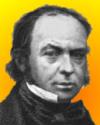
On 9 Apr 1806, the great Victorian civil and mechanical engineer, Isambard Kingdom Brunel was born. His life was one of great originality and productivity on many notable projects. In 1823, he began work with his father, Marc Brunel, on the Thames Tunnel, and later became the resident engineer at the site.
In 1829, Isambard designed a suspension bridge to cross the River Avon at Clifton. In 1831, he was appointed chief engineer at the Bristol Docks, and Brunel later designed the Monkwearmouth Docks and others at Plymouth, Cardiff, Brentford and Milford Haven. In 1833, age 27, he was appointed chief engineer of the Great Western Railway, the line that linked London to Bristol. He went on to build more bridges, viaducts, and three steam ships.
A passenger on board the the first voyage of the Steam-ship Great Western, sailing from Bristol to New York, April, 1838, kept a journal. It was published in an American newspaper, and so it survives for us to read. Share the excitement he felt, and the interesting story he tells, in his Journal Of the First Voyage of the Steam-ship Great Western, April 1838.

On 9 Apr 1806, Isambard Kingdom Brunel was born, rightly admired as one of the greatest of all engineers. His leading role in the transport revolution of the nineteenth century, left an indelible mark on the British landscapeand engineering history. His projects included railways, tunnels, bridges, and great steamships. If you know little about this astonishingly productive Victorian, it is time to remedy that! Today's book pick is: Brunel: The Life and Times of Isambard Kingdom Brunel, by Angus Buchanan, who, as Emeritus Professor of the History of Technology at the University of Bath, is well-qualified to spellbind you with Brunel’s ebullience, foresight, hard work and ambition.
It is available from Amazon, typically about New from $389.99. Used from $2.96. (As of earlier time of writing - subject to change.)
 | While electric railroading is perhaps the most important branch of electrical engineering, at least as regards commercial importance, considering the amount capital invested therein, nevertheless it is a remarkable fact that while most other branches of electrical engineering had been developed to a very high degree of perfection, even a few years ago theoretical investigation of electric railroading was still conspicuous by its almost entire absence. All the work was done by some kind of empirical experimenting, that is, some kind of motor was fitted up with some gearing or some sort of railway car, and then run, and if the motor burned out frequently it was replaced with a larger motor, and if it did not burn out, a trailer was put on the car, and perhaps a second trailer, until the increase of the expense account in burn-outs of the motors balanced the increased carrying capacity of the train. |
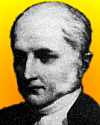 | I had come to the conclusion, that the principal alimentary matters might be reduced to the three great classes, namely the saccharine, the oily and the albuminous. |
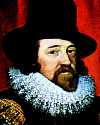 | Truth more easily comes out of error than out of confusion. |
| Before you look at today's web page, see if you can answer some of these questions about the events that happened on this day. Some of the names are very familiar. Others will likely stump you. Tickle your curiosity with these questions, then check your answers on today's web page. | |
| Births | |
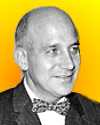 | J. Presper Eckert, Jr., born 9 Apr 1919, was an American engineer and co-inventor of the first general-purpose electronic computer, a digital machine that was the prototype for most computers in use today. In 1946, Eckert with John W. Mauchly fulfilled a government contract to build a digital computer to be used by the U.S. Army for military calculations. What was this computer named? |
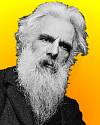 | Eadweard Muybridge, an English photographer, born 9 Apr 1830, is remembered for his pioneering work in photographic studies of motion. One notable example is his series of photographs of a running horse which answered what had been a hotly debated issue. What question about a horse's gait did Muybridge solve? |
 | Isambard Kingdom Brunel, an English civil and mechanical engineer, born 9 Apr 1806, had great originality and was highly productive. His outstanding projects include railways, tunnels, bridges, viaducts and steamships (including the first transatlantic steamer). His largest steamship was used to lay a transatlantic telegraph cable. What was the name of Brunel’s largest steamship? |
| Deaths | |
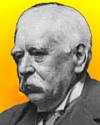 | Sir Patrick Manson (1844-1922) was a Scottish parasitologist who founded the field of tropical medicine developing it as a distinct field of study. He was the first to discover (1877-79) that an insect can be host to a developing parasite (the worm Filaria bancrofti) that is the cause of a human disease (filariasis, which occurs when the worms invade body tissues). What insect did Manson identify as the host for spreading this parasitic worm? |
| Events | |
 | In 1959, NASA announced the selection of America’s first seven astronauts for project Mercury that had been chosen from 110 applicants. Project Mercury, NASA's first high profile program, was an effort to learn if humans could survive in space. NASA required astronaut candidates to be male, not over 40 years old, not more than 5' 11" height and in excellent physical condition. One of them became the first American in space in 1961. What are the names of two of these famous astronauts? Or, try for all seven names. |
Fast answers for the previous newsletter for April 8: radioactive isotope carbon-14 as a tracer • the pituitary • Otis traveled upward on a demonstration elevator, and at top called for the elevator’s cable to be suddenly cut with an axe. • 3D motion picture, viewed wearing spectacles with one red and one green lens to produce the illusion of depth • largest sunspot group ever on record.
 If you enjoy this newsletter, the website, or wish to offer encouragement or ideas, please send feedback by using your mail reader Reply button.
If you enjoy this newsletter, the website, or wish to offer encouragement or ideas, please send feedback by using your mail reader Reply button. Your click on a Facebook, StumbleUpon, or other social button on the site webpages is also a welcome sign of appreciation. Thank you for using them.
© This newsletter is copyright 2020 by todayinsci.com. Please respect the Webmaster's wishes and do not put copies online of the Newsletter — or any Today in Science History webpage. (If you already have done so, please remove them. Thank you.) Offline use in education is encouraged such as a printout on a bulletin board, or projected for classroom viewing. Online, descriptive links to our pages are welcomed, as these will provide a reader with the most recent revisions, additions and/or corrections of a webpage. For any other copyright questions, please contact the Webmaster by using your mail reader Reply button.
--
If you do not want to receive any more newsletters, Unsubscribe
To update your preferences and to unsubscribe visit this link
Executive Real Estate Business Class
-
"It was like a man with wings. It wasn't like anything you'd see on TV or in a monster movie." ...
About the publisher
Search This Blog
Blog Archive
-
▼
2020
(1542)
-
▼
April
(134)
- ANIMALS: The rush to get a dog
- On This Day for April 30 - George Washington inaug...
- Medical Association Confirms Hydroxychloroquine 90...
- Newsletter for Thursday 30 April.
- April 30: Hitler Commits Suicide but What Happened...
- SCIENCE: The Spinosaurus is scarier than we thought
- Demystified: What’s the Difference Between a Bee a...
- On This Day for April 29 - British royal wedding, ...
- Breaking News and Historians in the News from HNN
- Is this Global Infection-induced Stealth Euthanasi...
- Newsletter for Wednesday 29 April.
- April 29: The Fall of Saigon and the Master of Fak...
- Family: 12 ideas to keep kids busy this week
- TRAVEL: Seeing from afar—the best photography books
- On This Day for April 28 - Benito Mussolini execut...
- Where did those 1600 Nazi Doctors go that were bro...
- Where did those 1600 Nazi Doctors go that were bro...
- Newsletter for Tuesday 28 April.
- April 28: James Cook Lands at Botany Bay, Mutiny o...
- HISTORY: Battling a pandemic so women could vote
- On This Day for April 27 - Independence for Sierra...
- New Op Eds This Week on History News Network
- NY Policy Results in Widespread Nursing Home Elder...
- Newsletter for Monday 27 April.
- April 27: Spanish Settle in the Philippines, Labor...
- SPECIAL: Family guide: Keeping your kids moving!
- The Last Kingdom | Historical quiz questions | Rom...
- On This Day for April 26 - Chernobyl nuclear accid...
- Data tells a drastically different story than what...
- Newsletter for Sunday 26 April.
- April 26: The Great Debate, Chernobyl and Oscar Wi...
- On This Day for April 25 - Hubble Space Telescope ...
- Save your life by using a mask correctly - Can pro...
- Newsletter for Saturday 25 April.
- CORONAVIRUS SPECIAL EDITION: What you need to know...
- April 25: The Guillotine, DNA and the 1st Solar Ba...
- PHOTOGRAPHY: Honoring those who help us every day
- How A Devastating Plague May Have Hastened The Dem...
- On This Day for April 24 - Installation of Pope Be...
- This Week's Roundup Top Ten from History News Network
- Newsletter for Friday 24 April.
- COVID 19 Research, the Nuremberg Code for research...
- April 24: War! What is it Good For?
- YOUR WEEKLY ESCAPE: The secrets hidden in a 500-ye...
- Truth Needs a Champion. Is It You?
- ANIMALS: More cats with the coronavirus. Should I ...
- On This Day for April 23 - Voting for Eritrea's in...
- Newsletter for Thursday 23 April.
- April 23: Defeat of the Vikings, Robert E. Lee and...
- SCIENCE: Beyond Greta: Who’s fighting for the Eart...
- Earth Day Special Edition: Today, let the planet i...
- Demystified Video: What's Inside the Great Pyramid?
- On This Day for April 22 - First Earth Day, Miguel...
- Breaking News from History News Network
- What do you think so far?
- Newsletter for Wednesday 22 April.
- April 22: Portugal Claims Brazil, Barbara Walters ...
- TRAVEL: Marooned at sea, 95,000 people
- On This Day for April 21 - French elections held, ...
- Newsletter for Tuesday 21 April.
- Your support empowers our scientists, explorers an...
- April 21: Babur Establishes the Mughal Empire, Tir...
- The step-by-step plan we are experiencing is expla...
- HISTORY: When George Washington was an epidemic fi...
- On This Day for April 20 - Explosion on the Deepwa...
- This Week's New Op-Eds on History News Network
- Corrected Link: Globalist Plan Rolling Out now cre...
- Globalist Plan Rolling Out now creating global pol...
- Newsletter for Monday 20 April.
- April 20: Pasteurization, Marie Curie Isolates Rad...
- SPECIAL: Coronavirus family guide: 'Back' to school
- VE Day at 75 | The scandalous lives of the Byrons
- On This Day for April 19 - American Revolution beg...
- Newsletter for Sunday 19 April.
- April 19: The 'Shot Heard Round the World' and How...
- Family: It's almost Earth Day! Create your own saf...
- The Compass: Earth Day 50th anniversary edition
- On This Day for April 18 - The midnight ride of Pa...
- Major Media (Fox included) Lies for the Deep State...
- Newsletter for Saturday 18 April.
- Our award-winning storytelling goes further.
- April 18: The 'Regulars are Coming!' and the Life ...
- CORONAVIRUS SPECIAL EDITION: People are having biz...
- PHOTOGRAPHY: On the ground in Nairobi as COVID-19 ...
- On This Day for April 17 - Canada Act proclaimed, ...
- The Roundup Top Ten from History News Network!
- Newsletter for Friday 17 April.
- April 17: The Bay of Pigs Invasion and the Boxing ...
- YOUR WEEKLY ESCAPE: Majestic photos of the tallest...
- Free Download: Britannica's Chrome Extension
- ANIMALS: The quarantine lifeline of a dog (or cat)
- On This Day for April 16 - Harriet Quimby's flight...
- Newsletter for Thursday 16 April.
- April 16: Madame Tussaud's Bloody Background
- SCIENCE: Ways to see what the world could be
- Discover Ancient Sparta with National Geographic H...
- Demystified: Can Eating Too Many Carrots Make Your...
- On This Day for April 15 - Sinking of the Titanic,...
- Breaking News from HNN
- Newsletter for Wednesday 15 April.
-
▼
April
(134)
-
Blogroll
-
About
HistoryFact










0 comments:
Post a Comment